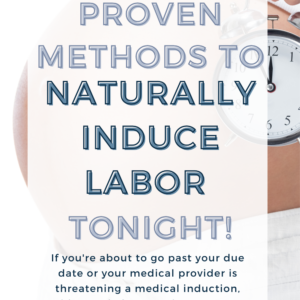It has many names – prodromal labor, false labor, Braxton Hicks and practice labor. Are you wondering what it is? You aren’t alone! Prodromal labor can be confusing. Learn everything you need to know about prodromal (false) labor, what to do if you are and how to tell the difference between real and false labor.

What is Prodromal Labor?
Prodromal labor, often called “false labor”, is when you have symptoms of labor, but it doesn’t actual result in labor.
You’ll have contractions, but they won’t have a consistent pattern or increase in strength. These contractions also aren’t known to cause any cervical changes like dilation or effacement.
Related: What are Labor Contractions and What Exactly Do They Do?
That’s where the term false labor comes from, but there isn’t anything false about it. Prodromal labor will happen intermittently, usually during the two months leading up to birth, until you’re ready to begin real labor. That’s not to say that it isn’t a necessary part of the pregnancy and labor journey.
Practice Labor has a Purpose
Practice labor sounds annoying. Contractions without labor progressing at all or the chance to meet baby? Ugh.
Prodromal labor does a lot to prepare the body and mind for labor and delivery!
First, it prepares your body. If you’re a first time mom, that means your body has never delivered a baby before. And if you’re already a mom, it’s probably been a while since your last birth. Practice labor gives your body the change to – well, practice! It gives your uterine muscles a change to get ready and understand what they’ll need to do during labor and delivery.
False labor doesn’t just allow your body to practice, it allows your mind to practice. Labor is just as much mental as it is physical. Use the time you’re in prodromal labor to practice your relaxation techniques. Try out comfortable positions to refer back to during real contractions.
Explain to your partner or doula what the contractions feel like so they have a better understanding of how to help you during labor.
So even though prodromal labor isn’t fun and can be annoying, think of it as a way to begin preparing your body and practicing your relaxation techniques to get ready for the big day.

Prodromal Labor vs Real Labor
Prodromal labor will come and go intermittently during the two months leading up to your delivery day. Like all things related to L&D, if you get false labor, how long it lasts and the intensity of it will vary from woman to woman.
If you’re experiencing mild contractions, you might be wondering if you’re in real or prodromal labor. There are a couple of ways you can tell.
1. Movement
One of the easiest ways you can tell if you’re in practice labor is by changing positions. Movement will cause false labor contractions to stop or change.
Start walking around, sit down or change position. If you notice the contractions stop or go away then you’re in false labor. Real labor contractions won’t change strength no matter what you do. Some activity or positions may provide you more comfort and ability to relax but it won’t change the intensity of a contraction if it’s real labor.
2. Strength
Practice labor contractions are typically mild in intensity. Most women report them feeling like a strong period cramp. You’ll also notice them in the front of your belly or abdomen. Real contractions tend to wrap the whole way around your belly and even into your back.
False labor contractions also won’t increase in intensity at all. Whether you experience false labor for a few hours or off and on for a few days, the contraction won’t increase in strength or get any harder.
With real labor, you will unavoidably notice if contractions get stronger and harder. They’ll increase intensity as your progress through the stages of labor until you’re ready to push.
Related: The Four Stage of Labor – It’s More than Just Contractions!
3. Timing
Lastly, if you’re still not sure if you’re in real labor, it’s time to start timing your contractions.
Real labor contractions can start off with a random pattern, but as labor goes on they’ll soon establish a steady pattern. You’ll be able to tell when another contraction is coming and how long it will last.
False labor contractions are random. They have no pattern when it comes to their frequency or duration. Each one will vary a lot in how long it lasts and how far apart it is from another one. They’ll go on this way until they stop all together.
If you’re using time to know whether or not you’re in real labor, make sure you’re timing your contractions the correct way!

What Do I During Prodromal Labor
There isn’t anything you need to do. Since practice labor often feels like just a mild period crap, it shouldn’t bother you too much or get in the way of work or your daily activities. However, if false labor is annoying you or you’re beginning to feel fatigued from it, here are some things you can try:
- Change positions – This typically lessens or stops false labor all together.
- Take a warm (not hot) bath. The warm water loosens muscles and can help you relax.
- Drink plenty of water and eat nutritious foods. Prodromal labor can turn into real labor. It also can be tiring for your mind and body. Gear up for labor or simply refuel by staying hydrated and eating healthy meals.
- Don’t try to naturally induce labor. Trying to briskly walk or bounce on a ball to help speed contractions won’t work. False labor isn’t real labor. The contractions aren’t changing your cervix or increasing in strength or duration. No need to tire yourself out for no reason. Especially if real labor is around the corner, you’ll want to be rested and ready!
True Labor Signs
Now that you know what false labor is, let’s talk for a minute what real labor is like.
The easiest way to tell is by keeping track of your contractions. Measure the frequency, duration and intensity. You’ll notice a pattern develop after about an hour.
Most first time mamas don’t know how to time their contractions correctly. They don’t know if they’re in active labor or arrive at the hospital or birth center too soon or too late. Learn how to time your contractions correctly or download an easy-to-use app as you near delivery day.
Labor signs can differ from mom to mom. The most reliable sign is a pattern in contractions that continue to increase in duration, frequency and intensity. The feeling may start like a mild period cramp or a low, dull ache in your abdomen.
The pain level of your contraction depends a lot on YOU. Birth education and learning and preparing for labor with relaxation techniques, creating a birth plan, assembling your birth team and creating your ideal birth environment.
True Labor Signs
True labor signs will vary from mom to mom and pregnancy to pregnancy. These signs may indicate that you’re in labor or that labor is approaching.
- A pattern in labor contractions
- Low, dull ache in the abdomen
- Vaginal or rectal pressure
- Losing your mucus plug
- Bag of waters breaking
The Truth About Real Labor vs Prodromal Labor
Getting ready to meet your baby and knowing that means putting in some hard work first can lead to a complication mix of excited, nervous and scared emotions.
Plus, every cramp and twinge during pregnancy leads to a Google search, which sends all pregnant mama down the rabbit hole.
The truth is your body knows what is and isn’t real labor. Whether YOU know or not isn’t a big deal. Your body knows what it’s doing. When the time comes for real labor, as long as you’ve prepared yourself for everything that comes mentally and physically on the big day, you’ll know what to do too.











Leave a Reply